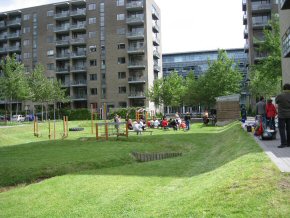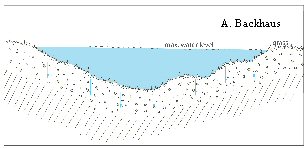Dry basins
Dry basins (temporarily flooded depressions, detention basins) act as run-off dams during rainy periods and dry up during the following dry period (see figures 1 and 2). Dry basins can be constructed with or without a base membrane. Without a membrane, there may be some seepage, but this is typically too slow to match the required emptying time, usually one to three days. Low-flow discharge (discharge through a pipe of smaller diameter than the in-flow pipe) to the sewer or a natural recipient facility is normally used. A membrane is used where groundwater pollution is a concern. As all the water drains away, dry basins have less impact on particle removal. However, some particles will remain, especially if there is grassy vegetation.

Figure 1: Playground in Ørestad, Copenhagen, which acts as a dry basin (Photo: Christian Nyerup Nielsen)

Figure 2: Dry basin after stormwater rainfall (completely full) (Sketch: A. Backhaus)

